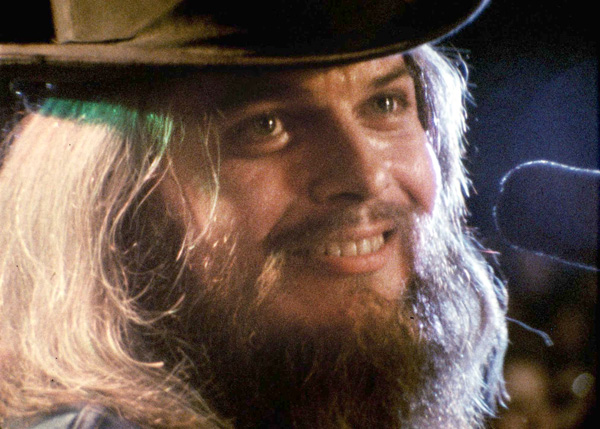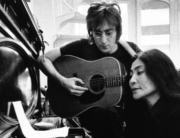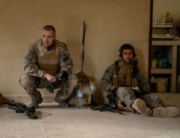Les Blank’s A Poem Is a Naked Person is a beautifully restored 1974 rock ‘n’ roll time capsule of Leon Russell. It’s similarly eye-opening as the 1970s R & B outtakes in Soul Power, the Rolling Stones’ archival releases of Charlie Is My Darling–Ireland ’65 and 1969’s Get Yer Ya-Ya’s Out!, and DA Pennebaker’s 65 Revisited for its extras of Bob Dylan.
For a performer who started out as a young session musician with The Wrecking Crew, then onto a solo career and induction into the Rock and Roll Hall of Fame in 2011, Russell practically embodies the history of Southern rock, with his roots proudly showing. The film was originally commissioned by Russell, and Blank tightly filmed him with his rock band in concert performing hits like “Tight Rope” and “A Song for You.” Blank goes further, taking a 360-degree approach over two years to reveal all the influences on Russell’s sound during sessions at the musician’s recording studio in Oklahoma. The footage captures the making of the first time Russell took on the “Hank Wilson” persona when he released what would become a series of four Americana albums to differentiate from his rock records.
However, Russell must have gotten more than he bargained for. He didn’t approve a theatrical release of the film for more than 30 years, until Blank’s son Harrod reached out to him, a few months before his father died in 2013, with the proposal to restore his father’s 2011 edit of the 16mm footage. His father, the late idiosyncratic chronicler of outsider artists, worked in the John and Alan Lomax tradition of collecting songs and stories in situ. He was a cinematic ethnomusicologist, and Russell pays fond tribute to the two with his rendition of “Goodnight Irene” by the Lomaxes’ discovery Leadbelly.
The opening credits on tree signs establish a down-home feel, before a long-married couple comment bemusedly on watching the barn-like studio rise up along a river, replacing a popular fishing dock. A New Orleans brass band in a second line parade segues into Russell’s rollicking version of Hank Williams’s “Jambalaya,” that first brought the rhythms of the bayous to national attention. (Blank’s footage of black Creole music and culture traditions in Louisiana was expanded into his documentaries Dry Wood and Hot Pepper.)
At this Ozarks crossroads, Russell showcases Appalachian ballads, bluegrass, old time and contemporary country, folk revivalists (songwriter Eric Andersen, in particular), blues, African percussion, and gospel. Guest vocalists including country crooner George Jones (who died in 2013) in his prime; along with album co-producer, and fellow Oklahoman, the late J.J. Cale (who died the same year); and a young Willie Nelson. While Mama Cass is glimpsed at one point with a tambourine, and the late Johnny Gimble (who just died in May) with his swing time fiddle, most of the renowned Nashville Cats session musicians are not specifically identified, such as keyboardist Hargus “Pig” Robbins and guitarist Billy Byrd from Ernest Tubbs’s Troubadours. The many women singers were nationally unfamiliar names, but they are stellar examplars of the haunting styles that inspired the Coen Brothers for O Brother, Where Art Thou? (Any fan of that best-selling soundtrack will want to see this film, too.) Bob Dylan was the only musician, more or less famous, passing through Russell’s studio who wouldn’t let himself be filmed by Blank.
Blank also interplays each piece with scenes of regional color: square dancers, storytellers of local legends (some showing off for the camera), a snake with a baby chicken (that was hard to watch), and Austin artist Jim Franklin at work painting imaginative landscapes onto an empty swimming pool. (Franklin also designed the poster for the film’s release.) Of the many lovely sunsets over the water, one is accompanied by Russell’s plaintive “I’m So Lonesome I Could Cry,” in tribute to Hank Williams.
The changing times are indicated as well. The only canned music video-style segment is staging “Shoot Out on the Plantation” with Russell playing at an old plantation now rented out for wedding parties. In downtown Tulsa, the Art Deco Bliss Hotel is spectacularly demolished for urban renewal, and the gawkers include a nostalgic man who watched it being built in 1929. The concluding sequence emphasizes continuity and the religious roots of secular music, as the edit goes back and forth between a passionate preacher with his gospel choir and Russell rocking to the same rhythms with his studio musicians.
The cultural heritage of the South as a living, breathing, rocking and rolling inspiration is wonderfully preserved through this film.

















Leave A Comment